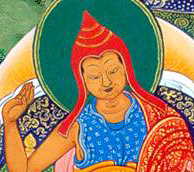Kamalaśīla
| PersonType | Category:Classical Indian Authors |
|---|---|
| MainNameTib | པདྨའི་ངང་ཚུལ་ |
| MainNameWylie | pad+ma'i ngang tshul |
| MainNameSkt | Kamalaśīla |
| YearBirth | 713/740 |
| YearDeath | 763/795 |
| ReligiousAffiliation | Nalanda |
| StudentOf | Śāntarakṣita |
| BDRC | https://www.tbrc.org/#!rid=P7641 |
| IsInGyatsa | No |
| PosBuNayDefProv | Provisional |
| PosBuNayDefProvNotes | "In another context, Kamalasila quotes the passage from the Latikâvatârasütra cited by Candraklrti as scriptural authority for Buddha-nature being of provisional meaning. Kamalasila himself, though, does not put it quite that way, stating only that, in accord with the various outlooks of sentient beings, the Buddhas taught what is a single dharmadhâtu (or dharmanairâtmya in the Lankâvatârasütra) by means of many different expressions (including the expression “Buddha-nature”), that is, in conventional terms." Kano. K., Buddha-Nature and Emptiness, p.11. |
| PosAllBuddha | Qualified Yes |
| PosAllBuddhaNote | In the sense that all beings have the potential to achieve Buddhahood. |
| PosAllBuddhaMoreNotes | "The teaching “all sentient beings have Buddha-nature” is
interpreted in the sense that all sentient beings are pervaded by the dharmadhätu, which is characterized by selflessness. In other words, the tathägatagarbha is taken to be the dharmadhätugarbha. Though the term dharmadhätugarbha appears in the RGVV, Kamalasila's interpretation seems to have been derived from a phrase in the Lankävatärasütra, “the embryo of the tathägata, which is selflessness” (tathägatanairätmyagarbha),reinforcing the notion that Buddha-nature does not refer to ätman but rather to selflessness (nairātmya)." Kano. K., Buddha-Nature and Emptiness, p. 10. |
| PosYogaMadhya | Madhyamaka |
| PosVehicles | 1 |
| PosVehiclesNotes | "In his Madhyamakäloka, Kamalasila presents the position of an opponent who takes the three-vehicle theory to be definitive. He refutes that position and makes the case for the single-vehicle theory being definitive by quoting a number of sutra passages." Kano. K., Buddha-Nature and Emptiness, p. 9. |
| PosEmptyLuminNotes | Karl includes him in the first category (emptiness), but he seems to fall somewhere between that and the second (luminous nature), which he defines as selflessness (nairātmya).
|
| Other wikis |
If the page does not yet exist on the remote wiki, you can paste the tag |

